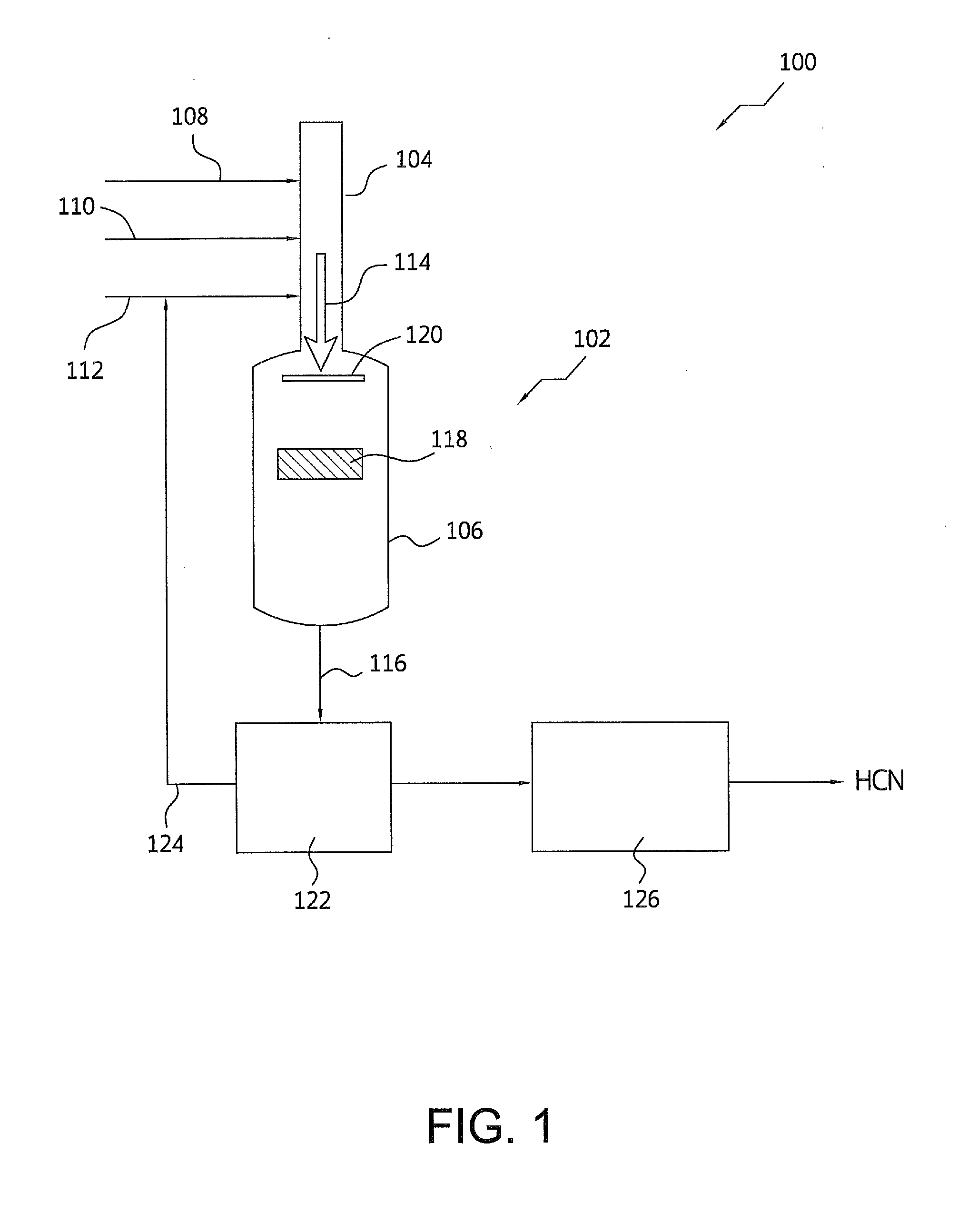Processes for producing hydrogen cyanide using static mixer
a technology of hydrogen cyanide and static mixer, which is applied in the direction of manufacturing tools, transportation and packaging, cooking vessels, etc., can solve the problems of affecting the economics of hcn manufacturing, affecting the ability of manufacturers to meet the needs of customers, and affecting the production efficiency of hcn
- Summary
- Abstract
- Description
- Claims
- Application Information
AI Technical Summary
Benefits of technology
Problems solved by technology
Method used
Image
Examples
example 1
[0089]As illustrated in FIG. 2, a plurality of tabs having an I-shape support are inserted through corresponding non-continuous slots on an elongated conduit to form one row of four tabs in a first static mixing zone and three rows of four tabs in a second static mixing zone to form the mixing vessel. The first static mixing zone is positioned between the inlet port of the methane and ammonia containing gas and the second static mixing zone is positioned between the inlet port of the oxygen-containing gas and outlet port. Each tab has an angle of 30°±1°, except for the bottom row in the second static mixing zone where the tabs have an angle of 25°±1°. Each tab has a surface area that is approximately 77.5 cm2. Each tab is inserted from the inside of the elongated conduit and is welded to the external surface of the elongated conduit. Tabs from one row align with the adjacent rows and tabs from the first mixing zone align with tabs from the second mixing zone. The degree of cant of t...
example 2
[0092]Methane and ammonia-containing reactant gases are fed to the first static mixing zone and oxygen-containing reactant gas is fed to the second static mixing zone. The reactant gases are fed at an methane-to-oxygen molar ratio of 1.2 and an ammonia-to-oxygen molar ratio of 1:1.5 to produce a ternary gas mixture containing approximately 28.5 vol. % oxygen. The ternary gas mixture is then fed to a reactor vessel having a 85 / 15 platinum / rhodium catalyst on a flat catalyst bed. The reaction temperature is from 1000° C. to 1200° C. Using the exemplary mixing vessel of Example 1, the ternary gas mixture has a coefficient of variation (CoV) of less than 0.1 across the catalyst bed. The operating pressure of the static mixer may vary from 130 kPa to 400 kPa. In addition, pressure drop within the exemplary mixing vessel of Example 1 is less than 35 kPa.
example 3
[0093]Using the exemplary mixing vessel of Example 1 and under similar reaction conditions as Example 2, the catalyst bed has a bed temperature variation from 15° C. to 25° C. across the bed. This bed temperature variation would indicate a thoroughly mixed ternary gas mixture. In contrast, the static mixer of Comparative A, under similar reaction conditions as Example 2, produces a ternary gas mixture that would result in a bed temperature variation of 35 to 100° C. across the bed. Poor mixing of the static mixer of Comparative A may be attributed to the difficultly in aligning tabs by welding to the inside of elongated conduit.
PUM
| Property | Measurement | Unit |
|---|---|---|
| Temperature | aaaaa | aaaaa |
| Temperature | aaaaa | aaaaa |
| Angle | aaaaa | aaaaa |
Abstract
Description
Claims
Application Information
 Login to View More
Login to View More - R&D
- Intellectual Property
- Life Sciences
- Materials
- Tech Scout
- Unparalleled Data Quality
- Higher Quality Content
- 60% Fewer Hallucinations
Browse by: Latest US Patents, China's latest patents, Technical Efficacy Thesaurus, Application Domain, Technology Topic, Popular Technical Reports.
© 2025 PatSnap. All rights reserved.Legal|Privacy policy|Modern Slavery Act Transparency Statement|Sitemap|About US| Contact US: help@patsnap.com



